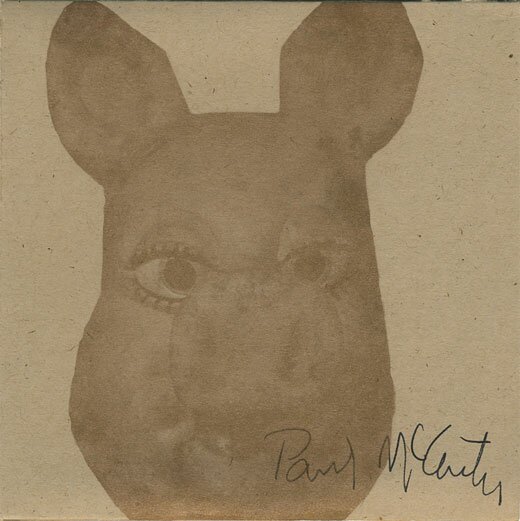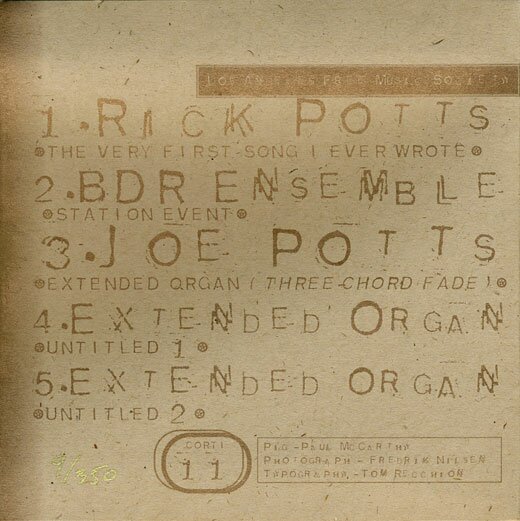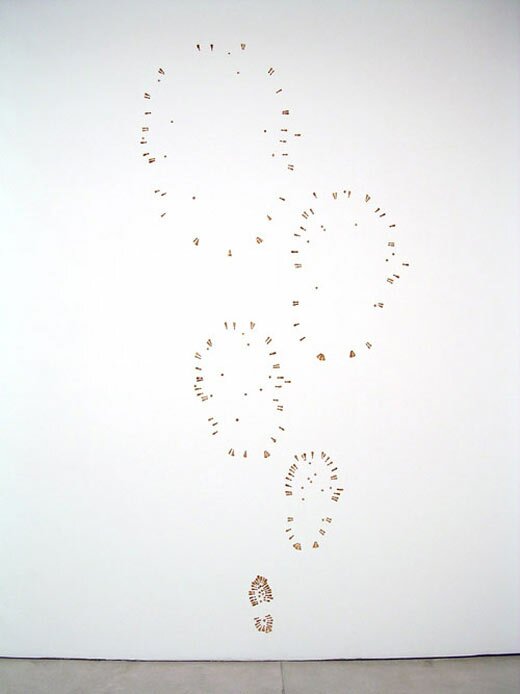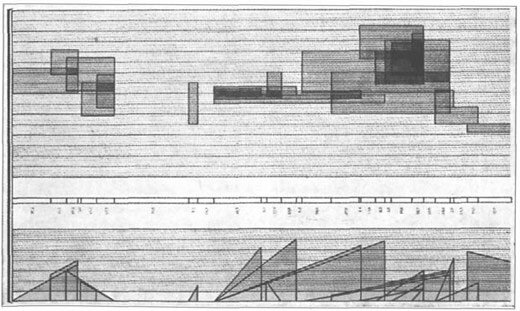music
Archived Posts from this Category
Archived Posts from this Category
Posted by ben on 24 Apr 2008 | Tagged as: design, music
Since I presumed to compare Brian Eno’s Music for Airports to Satie’s formulation of ‘furniture music’ in this post, I thought I’d let Mr. Eno have his say:
Whereas the extant canned music companies proceed from the basis of regularizing environments by blanketing their acoustic and atmospheric idiosyncrasies, Ambient Music is intended to enhance these. Whereas conventional background music is produced by stripping away all sense of doubt and uncertainty (and thus all genuine interest) from the music, Ambient Music retains these qualities. And whereas their intention is to ‘brighten’ the environment by adding stimulus to it (thus supposedly alleviating the tedium of routine tasks and leveling out the natural ups and downs of the body rhythms) Ambient Music is intended to induce calm and a space to think.
— Brian Eno, in the liner notes to Music for Airports
Posted by ben on 15 Apr 2008 | Tagged as: design, music
“Nevertheless, we must bring about a music which is like furniture — a music, that is, which will be part of the noises of the environment, will take them into consideration. I think of it as melodious, softening the noises of the knives and forks, not dominating them, not imposing itself. It would fill up those heavy silences that sometimes fall between friends dining together. It would spare them the trouble of paying attention to their own banal remarks. And at the same time it would neutralize the street noises which so indiscreetly enter into the play of conversation. To make such music would be to respond to a need.” — Erik Satie, prophesying Muzak.
Isn’t it interesting that architects have not taken up music as a part of their discipline? We have all this music now which is piped in but bears no particular relationship to the space which it inhabits. I suppose the only architectural sound works I’ve experienced are the pieces Max Neuhaus created for Dia:Beacon and Times Square. He’s on the verge of installing another permanent sound installation at the Menil in Houston on May 3, which will be only the third permanent sound work of his in the United States.
Neuhaus doesn’t conceive these works in the way that Erik Satie talked about ‘furniture music’ — he speaks instead of using the sound to “transform the space into a place” — and I think this notion is more socially sensitive than Satie’s conception. Satie’s idea is probably closer to Brian Eno’s Music for Airports, which, although it was created for a specific airport, was never “installed” in that space, and now exists as just another ambient recording.
Update: Just to clarify, what I’m talking about here is not the quality of Satie’s compositions, but his conception of ‘furniture music.’ Knowing that Max Neuhaus was a follower of John Cage’s, and that Cage studied Satie’s work very closely, I take Neuhaus’ work as a refinement of the idea of ‘furniture music.’ I’m not sure that he would see it this way, but this seems to be very a plausible thread. Since Neuhaus has had the opportunity to fully put this concept into practice in diverse environments, the idea naturally evolved from Satie’s original notion. What Neuhaus is doing seems to be less of a social intervention than what Satie talks about in the quote above — it changes your awareness of space, but doesn’t spare you the trouble of paying attention to banal remarks. The notion that Music for Airports is closer than Neuhaus’ installations to Satie’s concept of ‘furniture music’ may not be as defensible.
Posted by ben on 07 Apr 2008 | Tagged as: music, rock!, sound art

Mutant Sounds, one of the best underground music blogs out there, just posted a couple of albums by my all-time favorite San Antonio band, Crevice. These albums are long out of print, so if you are interested in learning just how weird San Antonio can get, grab these gems while you can. From the Mutant Sounds write-up:
Here’s a great offer by another friend of the blog, Uncle Buzz, aka Crevice. Wonderful space/cosmic, freaked out electronic compositions, amongst the best of its kind. The 1st one is a 71 minutes psych/cosmic electronic explorations lost in the depths of outer space. The second one consists of 4 log meditative sonic cosmic compositions, with eastern feeling sometimes, not far from the very early Tangerine Dream/ Kluster attempts.
Posted by ben on 04 Apr 2008 | Tagged as: design, image & sound, music, performance art

In another attempt to explore the intersection of music and visual art (see also), I give you a rare Los Angeles Free Music Society CD, on which Paul McCarthy plays alongside fellow artists John Duncan and Tom Recchion, photographer Fredrik Nilsen, and noise pioneer Joe Potts (of Airways). Included with an edition of The Lowest Form of Music box set, this CD includes a 30-minute organ drone by Potts, a recording of a radio “event” by the BDR Ensemble (Michael Delle Donne-Bhennet, John Duncan, and Tom Recchion), and some indescribable weirdness from Extended Organ (Joe Potts, Fredrik Nilsen, Paul McCarthy, and Tom Recchion). I’m including a few notes on the recordings below.
“3 CHANNEL CHORDS” was produced in an attempt to create an undulating mass of sound which seemed at first to be static drone while actually being a complex constantly mutating entity. The music was recorded in these separate takes on three tracks. Each track has sixteen channels of “CHOPPED OPTIGAN” run through a stereo mixer with the slide pots arranged to form a sine-wave pattern. Overt the course of thirty-plus minutes the sliders are constantly adjusted so that the sine pattern ripples across the mixer and then returns to the starting position. This formula is repeated on three separate channels, and then mixed down to stereo. I performed it and Rick Potts engineered it in his studio/living room. This recording marks the debut of the CHOPPED OPTIGAN.
— Joe Potts

BDR Ensemble: Michael Delle Donne-Bhennet / John Duncan / Tom Recchion * KPFK 90.7 FM-Los Angeles * Sponsored by Close Radio * December 1, 1977 * Duration 80 Minutes
Station Event was intended to use as a medium of communication rather than one of broadcast. It was performed live over Close Radio from two separate rooms: Delle Donne Bhennet (woodwinds and percussion), Recchion (invented instruments, piano and available materials) performed in KPFK’s Studio A. Paul McCarthy joined them toward the end of the work. From the control room, Duncan asked for and monitored phoned-in responses to what the ensemble was doing. Telephone calls and music from Studio A were mixed at the discretion of Steve Tyler, night engineer at KPFK. The two rooms were sound-separated, Tyler alone was able to hear the complete broadcast at its source.
— Tom Recchion

Posted by ben on 05 Mar 2008 | Tagged as: music, sound art
Following up on my post earlier this week about the history of the Wilhelm Scream, here’s a video about one of the most ubiquitous samples in contemporary music — the Amen Break. Like the Wilhelm Scream, the Amen Break has been woven into an astounding number of otherwise unrelated works from a wide range of styles and genres. Towards the end, this video also deals with the copyright issues surrounding sampling and appropriation art, and while it doesn’t really break any new ground in this respect, it may be of interest to those who haven’t spent much time with these issues.
Posted by ben on 11 Feb 2008 | Tagged as: music, performance art, silliness, sound art

That’s still another thing about the Correspondence School, it’s not just the letters, the postcards, the drawings, the poems, it’s also the New York Correspondence School objects. The Spam radio, for example, was a radio in the shape of a Spam can, which had a little handle on it, it was a thing the Spam Corporation made one year as an advertising gimmick. It was something they gave to people, and you could go to the beach with your Spam radio, and play your radio on the beach, it was a little radio inside of a Spam can, and I didn’t really treasure it very much so I gave it to Jim Bohn.
…
But to get back to that radio, I gave it to Jim Bohn — which is BOHN and not BONE — and the following week he was in Soho walking around with his wife and carrying the Spam radio as a kind of prize trophy. He was taking it out for a walk, and the minute I saw him with it I realized that he had given it some kind of notoriety and importance, and I was intensely jealous that he was walking around with the Spam radio and that I hadn’t thought of walking around with a Spam radio, like the time I had once walked around with the head of Candy Darling in a plastic bag. So still another week later, I was in Soho again and went to the supermarket and bought a real can of Spam and put a little handle on it, and then I was walking around with that.
Posted by ben on 03 Feb 2008 | Tagged as: music, poetry, video/film
The opening scenes of Bela Tarr’s brilliant Werckmeister Harmonies (music by Víg Mihály):
Posted by ben on 24 Jan 2008 | Tagged as: music, responses/reviews, sound art, video/film
Argentine artist Jorge Macchi has been all over South Texas lately — he was a resident at Artpace in 2005, he currently has a piece in the Triangle Project Space’s Standing on one foot, and the Blanton is showing Anatomy of Melancholy, his first “comprehensive U.S. exhibition,” through March 16.
As I wandered through the Blanton exhibit, I was reminded of the scene in The Breakfast Club when Allison (the “psycho” girl) puts on makeup and everyone realizes she’s a fox. Jorge Macchi has put in a lot of effort giving Fluxus a shave and a haircut, and what do you know, it fits very nicely into a standard gallery format. Macchi’s Caja de música, for instance, draws on the chance operations that ’60s experimentalists picked up from John Cage. Taking video of cars on a 5-lane highway, Macchi assigns a musical note to each lane, and as a car enters the frame the note corresponding to the lane it is in plays, creating a kind of randomized music box (you can watch this video on his site).

He’s also very fond of finding the edges of things, the demarcations, and focusing on those rather than the intended content of an appropriated work. For instance, at his Artpace residency, he took the final moments of several old movies and created video loops of the “The End” sequences. In an analogous move at the Blanton show, he cuts everything out of a map except the graveyards. These pieces draw our attention to the liminal moments, the insecurity of transition. Despite the summoning of these precarious situations, though, Macchi’s work feels very comfortable. He’s taken the ideas pioneered by Dada and Fluxus artists, art based on the awkward and the random, smoothed out the edges and made it feel very safe within the white walls of the museum.

There are some very elegant pieces in the Blanton show, including Caja de música, and Fuegos de artificio, a piece in which footprints made of soil expand outward on the wall, progressively losing their form like ripples on a pond. This is a concise and beautiful statement about the impact we have on the world as we move through it, bringing with us the dirt of another place, which gradually loses the significance of having come from our shoes.
But I’m left wondering whether the ideas Macchi draws from are best expressed with the sort of finesse and refinement he brings to them. Maybe the chance operations of Arp, Cage, Maciunas and all the others are better left in a raw form. Maybe Allison was hot without the makeup.
Posted by ben on 08 Dec 2007 | Tagged as: essays, music, r.i.p., responses/reviews, sound art

On the news of Stockhausen’s death, it may be worth reading this long essay on his work, which is still often misunderstood. This brief quote encapsulates some of the main ideas of the essay (by Jean-Claude Eloy):
The splendid success of the overall conception, general organization and production of “Zyklus” still do not always allow for the percussions to truly express their life and demonstrate all of their rich potential. On this matter, a work such as “Mikrophonie I” opens up surprising vistas and breaks down all barriers. The rich, but single, source for the whole work (the large tam-tam) is allowed ample time to “share” its multiple metamorphoses of tones, attacks, and resonances. Once again, with such a work, Stockhausen has shown himself to be a frontrunner, the boldest of all.
Throughout his work, Stockhausen’s dialectical personality is express by this double thrust, one rotating, the other ascending. One the one hand, he is truly audacious in his conceptual work and he knows how to impose a (sometimes “abstract”) form of thinking on musical material. And on the other hand, he possesses a very open sensitivity that studies material, listens to sounds created in the studio, analyzes their hidden pulsations, all to extract new meaning, go a step further and push the material forward.
Stockhausen’s double success in the two worlds of instrumental and vocal music – sound material that is already laden with history and acquired habits – as in the new realm of exploration of electro-acoustic technologies (a unique case in our times), can be understood by the presence of this dialectic that is constantly criss-crossing and circulating between two poles: from conception to material and from material to conception. Although ostensibly contradictory, these two poles are, in fact, complementary.
[Image above is a page from the score of Stockhausen's 1954 composition Studie II]
UPDATE: I decided to upload an MP3 of Stockhausen’s groundbreaking 1956 composition, Gesang der Junglinge. You can read more about this piece here. Enjoy.
Posted by michelle on 22 Oct 2007 | Tagged as: adventure day, music
Efterklang is a good way to start the day…
Posted by michelle on 15 Oct 2007 | Tagged as: art paparazzi, music, responses/reviews
 The City of Marfa endured an influx of Texas hipsters last weekend. Why would people drive eight hours to a former POW camp in West Texas? A free plate of barbecue courtesy of the Chinati Foundation and the chance to watch Sonic Youth in a small pavilion across the street from a Dairy Queen. San Antonio photographer Patrick Zeller drove out to Marfa and took some great photos of his West Texas journey here. There was a sprawling group show of more than 60 artists at Building 98 called Camp Marfa, a place where you could sit on a couch and watch a sort of Faces of Death version of competitive bull-riding accidents as well as a strikingly poetic series of explosions and slivers of nuclear test documentaries. Fort Russell was once a rest stop for famous generals and various U.S. presidents. The weathered, built in bar still houses a framed, velvet wall that kept high ranking medals. It’s a beautiful example of the art of absence, with the darkened blue velvet beneath the missing medals becoming accidental evidence of importance. There was a big West Texas contingent over at Building 98, with Jeffrey Wheeler at the helm. Wheeler and his brother run a space in Lubbock and started the ongoing, traveling exhibition called Ulterior Motifs. Some of the artists featured in this year’s show include Mel Chin, Bale Creek Allen, Daniel Johnston and Sharon Kopriva. I was in a last minute group show at a renovated restaurant at the edge of town called 500e. Austinites Sean Gaulager, Hank Waddell, Adreon Henry and Jacob Villanueva put the show together on a shoestring and a little bit of help from Vitamin Water and Sapphire Gin.[Sounds awful, but that combination incurs zero hangovers] After Sonic Youth, Adreon Henry’s band played for the meandering crowds. They will be playing again on Halloween if you are in the state capital that day. Over and out. More pictures?
The City of Marfa endured an influx of Texas hipsters last weekend. Why would people drive eight hours to a former POW camp in West Texas? A free plate of barbecue courtesy of the Chinati Foundation and the chance to watch Sonic Youth in a small pavilion across the street from a Dairy Queen. San Antonio photographer Patrick Zeller drove out to Marfa and took some great photos of his West Texas journey here. There was a sprawling group show of more than 60 artists at Building 98 called Camp Marfa, a place where you could sit on a couch and watch a sort of Faces of Death version of competitive bull-riding accidents as well as a strikingly poetic series of explosions and slivers of nuclear test documentaries. Fort Russell was once a rest stop for famous generals and various U.S. presidents. The weathered, built in bar still houses a framed, velvet wall that kept high ranking medals. It’s a beautiful example of the art of absence, with the darkened blue velvet beneath the missing medals becoming accidental evidence of importance. There was a big West Texas contingent over at Building 98, with Jeffrey Wheeler at the helm. Wheeler and his brother run a space in Lubbock and started the ongoing, traveling exhibition called Ulterior Motifs. Some of the artists featured in this year’s show include Mel Chin, Bale Creek Allen, Daniel Johnston and Sharon Kopriva. I was in a last minute group show at a renovated restaurant at the edge of town called 500e. Austinites Sean Gaulager, Hank Waddell, Adreon Henry and Jacob Villanueva put the show together on a shoestring and a little bit of help from Vitamin Water and Sapphire Gin.[Sounds awful, but that combination incurs zero hangovers] After Sonic Youth, Adreon Henry’s band played for the meandering crowds. They will be playing again on Halloween if you are in the state capital that day. Over and out. More pictures?
Posted by michelle on 07 Oct 2007 | Tagged as: music
Chingo Bling for El Presidente 2008 means Hillary you better learn some Spanglish. Sorry no posts this week, everyone seems to be incommunicado. Happy Birthday, Ben! Still in Marfa…
Posted by ben on 28 Sep 2007 | Tagged as: celebrity sightings, music, performance art, renegade performances, sound art
Posted by ben on 17 Aug 2007 | Tagged as: essays, music, sound art
Andrew Waggoner sends a 3,000 word battle cry into the ether, begging us to beat back the “colonization of silence” before it’s too late. He juxtaposes complaints about the overabundance of music in modern life (music while we shop; music while we drive; music while we wait for the AT&T customer service rep to answer our calls) with praise for the powerful use of silence by composers such as Webern and Morton Feldman. I can’t help but wonder if the solution to this problem is as simple as replacing Muzak with, say, the Lovely Music catalog.
On the other hand, here’s a video of John Cage . He, too, waxes eloquent on the limitations of “what we call music” (does this include Feldman?), and the power of silence. And somehow, in this 4-minute video, Cage seems to say more than Wagonner can pack into 3,000 words. You get the feeling that Cage has absorbed silence, that he embodies silence, while Wagonner pines away for it.
PS. Here’s another discussion of silence in the context of poetry for those that missed it.
Posted by ben on 13 Aug 2007 | Tagged as: music, rock!, video/film
I knew I had to find the antidote to that Hall & Oates video, and I think this is it. Mike Cooper has been one of my favorite musicians lately, embracing blues, free jazz, experimental electronics, and even exotica — and yet his recordings never sound contrived. Here’s a video for a recording he did back in 1984 with Tim Hill, Gary Jones and Paul Burwell (as Beating Time). This fits somewhere in the No Wave / Free Jazz Fusion territory…. Be sure to check out too.
Posted by ben on 19 Jul 2007 | Tagged as: adventure day, music, rock!, sound art
Emvergeoning’s NYC correspondent fvc sent the following account of a day on which mushrooms threaded together Max Neuhaus’ Times Square sound installation and the Boredoms’ recent “77 Boadrum” concert in a park under the Brooklyn Bridge. As luck would have it, I happened to get ahold of a recording of this very concert through another friend. Follow the link at the bottom of the post to download the MP3. Photos provided by generous Flickr users.
Several weeks ago some friends were sitting around at my apartment on a hot lazy sunday afternoon. They wanted some weed so they called a guy who sent his runner over with a briefcase of pot, hash, mushrooms, pills and powders, each in at least 2 or 3 varieties. The dealer even had a neat “menu” with descriptions of everything for sale. Drugs are a very professional service industry in Manhattan, if you have the right numbers.
Everyone bought some weed and then the dealer gave a 20 sided die to J — who called the number three and then tossed the die — a three. So he won a bag of mushrooms. After the sun set and we had gone to go look for a place to eat dinner, the mushrooms where left behind. They sat around my apartment for almost a month.
Posted by ben on 16 Jun 2007 | Tagged as: music, video/film
Phill Niblock film of Sun Ra’s Arkestra from 1966. A 16-minute version of this film has recently been released on DVD, and is . Niblock did a similar film of Arthur Russell, but it’s these days…